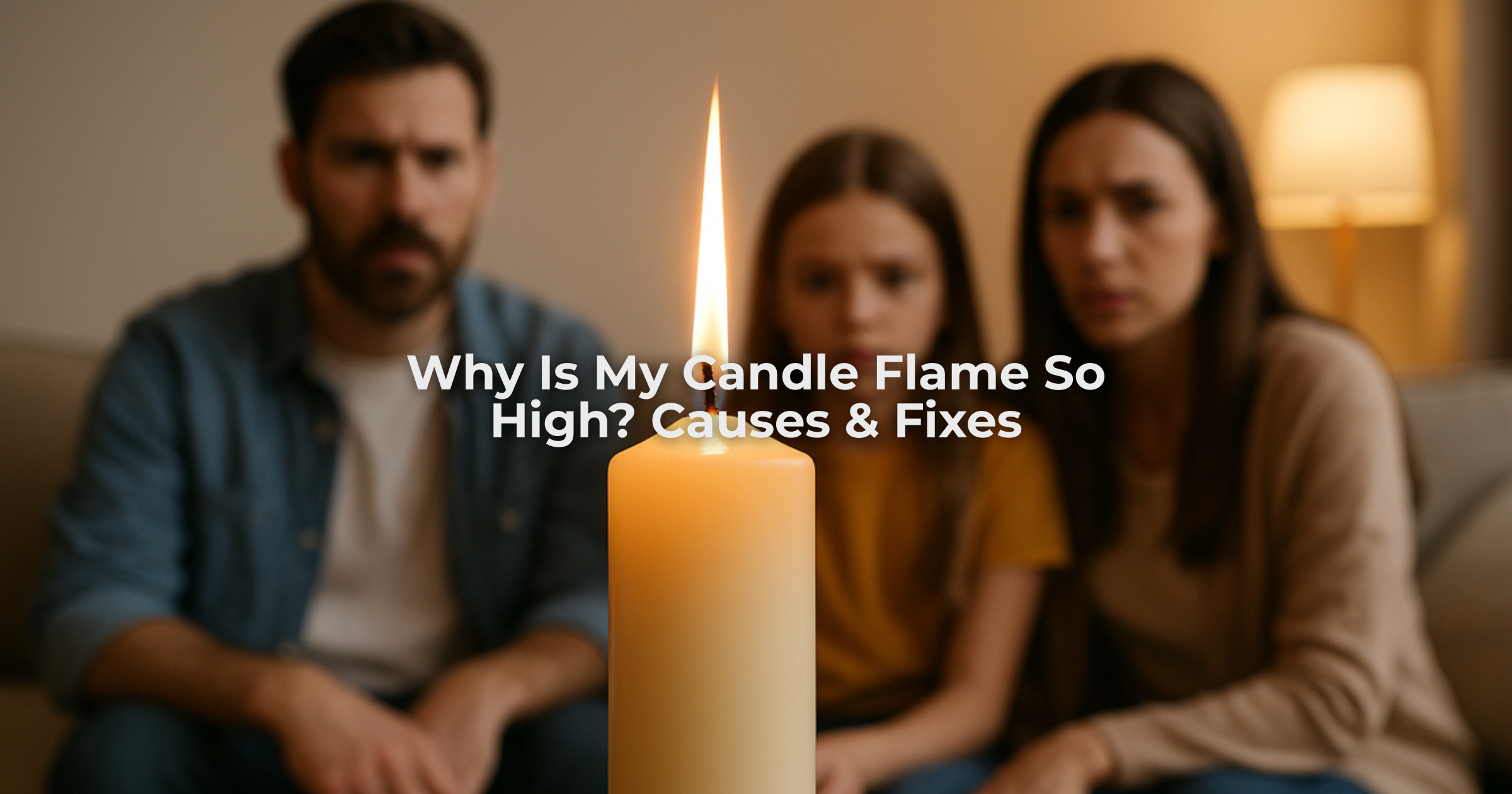No products in the cart.
Why Is My Candle Flame So High? Causes & Fixes
- Nav Preet
- No Comments

A candle flame burns too high when excess wax vapor and oxygen feed an overactive wick.
I’ve seen this many times while testing new wax blends for Karigar Style candles, and it often surprises people who assume a tall flame means a better burn.
In this post, I’ll explain exactly why your candle flame rises higher than normal, what’s happening inside that bright column of fire, and how to fix it safely.
You’ll also understand the balance between wick, wax, and air that keeps a candle burning steady and clean.
What Is a Candle Flame?
A candle flame is the visible part of a complex combustion process. When the wick absorbs melted wax, that liquid wax travels upward by capillary action and turns into vapor under heat.
These wax vapors mix with oxygen and ignite, producing the steady yellow light we recognize. A typical candle flame has distinct zones: a blue base where wax vapor burns cleanly, a bright yellow core where incomplete combustion creates light, and a faint outer veil where the flame meets fresh air.
When that combustion gets more fuel or oxygen than needed, the flame grows taller, hotter, and often starts to produce soot.
Understanding this basic structure helps identify what’s wrong when your candle flame seems unusually high or flickers aggressively.
Why Does a Candle Flame Burn So High?
A high candle flame is typically a sign of imbalance, excessive fuel, inadequate control, or environmental interference.
After years of making and testing candles with soy, paraffin, and beeswax, I’ve noticed a few reliable causes that almost always explain this behavior.
1. Wick Length and Material
If your wick is too long or made from the wrong material for the candle size, it will draw excessive melted wax. This creates an oversized flame that dances wildly and emits smoke.
Long wicks burn hotter and faster, which also shortens the candle’s lifespan. Trimming your wick to about one-quarter inch before every burn keeps the flame moderate and clean.
I’ve seen cotton wicks give steady, balanced flames, while thicker wood wicks need more trimming to stay within safe height limits.
2. Wax Composition and Additives
The kind of wax and additives you use heavily influences flame height. Dense or highly scented wax, especially that loaded with fragrance oils or colored dyes, tends to generate more vapor, which feeds the flame.
During my experiments with heavily perfumed paraffin blends, I noticed the flame often shot up for the first hour before stabilizing.
Lighter blends like soy wax or natural beeswax usually produce calmer flames because they release fuel at a slower, steadier rate.
3. Air Movement or Drafts
A flickering, towering flame often signals airflow issues. Fans, vents, or even open windows introduce constant oxygen flow that can make a flame rise higher and move erratically.
When I test candles for stability, I always check that the surrounding air is still. Drafts not only increase flame height but can also lead to tunneling or uneven wax melting.
Placing the candle in a calm environment prevents these problems and keeps the flame symmetrical.
4. Environmental Vibrations
Even slight vibrations from appliances or footsteps can disturb the melt pool and make the flame appear taller.
When testing candles in a busy room, I noticed the flame height would change whenever someone walked by or a speaker was playing.
The vibrations cause minor shifts in the wick’s fuel supply, altering combustion intensity. Setting your candle on a stable, vibration-free surface keeps its flame steady and consistent.
5. Candle Age or Storage Condition
Old candles can behave unpredictably. If a candle has been stored in heat or sunlight, its wax may have separated from additives, altering how it burns.
I once relit an old soy candle after a year, and the flame rose nearly double its normal height because the wax had partially dehydrated.
Proper storage in cool, dry conditions maintains wax consistency and ensures a balanced flame the next time you light it.
How to Fix a High Candle Flame?
A tall candle flame can be corrected easily once you understand what’s causing it. Each small adjustment affects how fuel, heat, and air interact.
When I troubleshoot candles for Karigar Style, I follow a simple process that any home user can apply.
1. Trim the Wick Regularly
The first and most effective fix is trimming the wick. Long wicks feed too much wax vapor into the combustion zone, causing a taller flame.
Use a wick trimmer or scissors before every burn to keep it around one-quarter inch. This small habit keeps your candle burning evenly, reduces soot on the glass, and prevents overheating.
After trimming, always remove any wick debris from the wax surface to avoid reignition.
2. Check Your Candle’s Environment
Burn your candle away from fans, air conditioners, and open windows. Airflow provides extra oxygen and makes the flame stretch upward or flicker sharply.
A steady environment ensures a stable wax pool and cleaner burn. When I test new batches, I place them in a wind-free corner to evaluate the wick’s true behavior.
You can try the same approach to see how your candle performs in still air versus near a draft.
3. Use Proper Burning Practices
Each burn session should last long enough for the wax pool to reach the edges of the container, usually two to four hours, but not beyond that.
Overburning can make the wick overheat and lengthen the flame. Letting the candle cool and solidify between uses helps reset the combustion balance.
Never leave a candle burning unattended, especially if the flame begins to flare or smoke.
4. Choose Quality Candles
If you’ve tried all these fixes and the flame still burns high, the problem may lie in poor manufacturing balance between wax and wick. Low-quality candles often use wicks that are too large for the container or wax blend.
Investing in quality candles made with pure soy, beeswax, or balanced paraffin blends ensures consistent performance. I’ve found that candles with cotton wicks and moderate fragrance loads offer the best stability.
Reliable brands test their wick-to-wax ratio for each product line to prevent high-flame behavior.
Final Thoughts
A high candle flame is rarely a mystery once you understand how wick length, wax quality, and air movement interact.
Most of the time, trimming the wick, keeping the environment still, and choosing balanced, well-crafted candles are all you need.
In my own studio testing, small corrections often turned an unstable, roaring flame into a calm and elegant glow.
If you love candles as much as I do and want clean-burning options designed with this balance in mind, explore Karigar Style’s handcrafted candles.
Frequently Asked Questions (FAQ)
What does a high flame on a candle mean spiritually?
Some people associate a tall candle flame with intense energy, focus, or strong intentions. Spiritually, it’s often seen as a sign of movement or manifestation. From a maker’s view, however, it’s mostly a physical response too much oxygen or wax vapor feeding the flame. Both meanings can coexist depending on your belief and observation.
How to lower a candle flame?
Start by trimming the wick to about a quarter inch before lighting. Ensure the candle sits away from drafts or vents that might boost oxygen flow. If the wax pool looks deep and liquid, let it cool completely before relighting. A properly maintained wick and calm environment usually bring the flame back to a safe height quickly.
How do you know if your candle spell is working?
In ritual use, a steady, centered flame often symbolizes focus or alignment, while a flickering or high flame may indicate dynamic energy or obstacles being cleared. Personally, when testing ritual blends, I pay more attention to burn quality—steady burn, low soot, balanced melt pool—because physical stability reflects good craftsmanship, which naturally supports symbolic intent.

Nav Preet is the founder and creative soul behind Karigar Candles. Inspired by heritage, nature, and the warmth of handmade artistry, she crafts candles that do more than glow—they evoke emotion. Through this blog, she shares her love for scents, styling, and mindful living, one flame at a time.
Creative Head at Karigar Style







